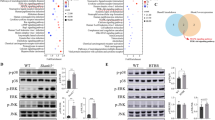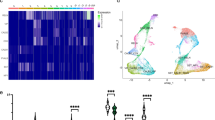Abstract
Temporal lobe epilepsy (TLE) is a complex neurological disease, and its occurrence and development are closely related to the autophagy signaling pathway. However, the mechanism by which electroacupuncture (EA) affects the regulation of autophagy has not been fully elucidated. TLE gene chip dataset GSE27166 and data from rats without epilepsy (n = 6) and rats with epilepsy (n = 6) were downloaded from Gene Expression Omnibus. The differentially expressed genes (DEGs) in the TLE and control groups were identified with the online tool GEO2R. Gene ontology (GO) and Kyoto Encyclopedia of Genes and Genomes (KEGG) databases were used to analyse the functional and pathway enrichment of genes in the most important modules. A rat model of TLE induced by lithium–pilocarpine treatment was established. EA treatment at DU20 and DU14 in TLE rats was performed for 2 weeks. Neuronal regeneration was determined using immunofluorescence staining. The protein levels of AKT/mTOR signaling pathway and autophagy markers were detected through western blotting and immunohistochemistry. This study identified 1837 DEGs, including 798 upregulated genes and 1039 downregulated genes. GO enrichment and KEGG analyses were performed on DEGs and revealed functional enrichment mainly in the mTOR signaling pathway and autophagy-animal. Furthermore, the number of mature neurons was significantly increased upon coexpressing BrdU/NeuN in TLE rats treated with EA. Western blotting and immunohistochemistry results showed significantly decreased levels of the phosphorylated-AKT and p-mTOR in the hippocampal CA3 and DG regions of TLE rats with EA treatment. And increased p-ULK1/ULK1, LC3-II/LC3-I and p62 levels in TLE rats with EA stimulation. Therefore, this study suggested that EA promoted autophagy in hippocampal neurons during the onset of epilepsy by regulating the AKT/mTOR signaling pathway to treat epilepsy.





Similar content being viewed by others
Data Availability
The datasets used and/or analysed during the current study are available from the corresponding author on reasonable request.
References
De Cooman T et al (2018) Adaptive heart rate-based epileptic seizure detection using real-time user feedback. Physiol Meas 39:014005
Sj E et al (2014) Can temporal lobe epilepsy surgery ameliorate accelerated long-term forgetting? Neuropsychologia 53:64–74
Ren Y et al (2020) EEG source estimation in a rare patient with cold-induced reflex epilepsy. Epileptic Disord 22:489–493
Allone C et al (2017) Neuroimaging and cognitive functions in temporal lobe epilepsy: a review of the literature. J Neurol Sci 381:7–15
Johnson EL (2019) Seizures and epilepsy. Med Clin North Am 103:309–324
Shu Y et al (2016) The Ephrin-A5/EphA4 interaction modulates neurogenesis and angiogenesis by the p-AKT and p-ERK pathways in a mouse model of TLE. Mol Neurobiol 53:561–576
Callenbach PM, Brouwer OF (1997) Hereditary epilepsy syndromes. Clin Neurol Neurosurg 99:159–171
Gano LB et al (2018) Altered mitochondrial acetylation profiles in a kainic acid model of temporal lobe epilepsy. Free Radic Biol Med 123:116–124
Phillips KF, Deshpande LS, DeLorenzo RJ (2018) Hypothermia reduces mortality, prevents the calcium plateau, and is neuroprotective following status epilepticus in rats. Front Neurol 9:438
Limanaqi F et al (2020) mTOR-related cell-clearing systems in epileptic seizures, an update. Int J Mol Sci 21:1642
Schneider M et al (2017) mTOR inhibitor reverses autistic-like social deficit behaviours in adult rats with both Tsc2 haploinsufficiency and developmental status epilepticus. Eur Arch Psychiatry Clin Neurosci 267:455–463
Pavlov I, Walker MC (2013) Tonic GABA(A) receptor-mediated signalling in temporal lobe epilepsy. Neuropharmacology 69:55–61
Ulamek-Koziol M et al (2019) Ketogenic diet and epilepsy. Nutrients 11:2510
Shen CC, Jiang JF (2019) Auricular electroacupuncture for Late posttraumatic epilepsy after severe brain injury: a retrospective study. Evid Based Complement Altern Med 2019:5798912
Sun ZG et al (2019) Effect of acupuncture at ST36 on motor cortical excitation and inhibition. Brain Behav 9:e01370
Tian H et al (2012) Acupuncture activates signal transduction pathways related to brain-tissue restoration after ischemic injury. Neural Regen Res 7:1866–1872
Bejarano E, Rodriguez-Navarro JA (2015) Autophagy and amino acid metabolism in the brain: implications for epilepsy. Amino Acids 47:2113–2126
Xu Z et al (2020) Targeting PI3K/AKT/mTOR-mediated autophagy for tumor therapy. Appl Microbiol Biotechnol 104:575–587
Wu XL et al (2015) Reduced Pumilio-2 expression in patients with temporal lobe epilepsy and in the lithium–pilocarpine induced epilepsy rat model. Epilepsy Behav 50:31–39
Racine RJ (1972) Modification of seizure activity by electrical stimulation: II. Motor seizure. Electroencephalogr Clin Neurophysiol 32:281–294
Linnoila J et al (2019) Mouse model of anti-NMDA receptor post-herpes simplex encephalitis. Neurol Neuroimmunol Neuroinflamm 6:e529
Biran I et al (2020) Interaction of temporal lobe epilepsy and posttraumatic stress disorder: network analysis of a single case. Front Psychol 11:1010
Mueller SG et al (2012) Different structural correlates for verbal memory impairment in temporal lobe epilepsy with and without mesial temporal lobe sclerosis. Hum Brain Mapp 33:489–499
Dos Santos JG Jr. et al (2005) Electroacupuncture prevents cognitive deficits in pilocarpine-epileptic rats. Neurosci Lett 384:234–238
Cha MH et al (2010) Acute electroacupuncture inhibits nitric oxide synthase expression in the spinal cord of neuropathic rats. Neurol Res 32(Suppl 1):96–100
Dong SA et al (2020) The Role of melatonin in electroacupuncture alleviating lung injury induced by limb ischemia-reperfusion in rabbits. Med Sci Monit 26:e922525
Yan T, Zhang Z, Li D (2020) NGF receptors and PI3K/AKT pathway involved in glucose fluctuation-induced damage to neurons and alpha-lipoic acid treatment. BMC Neurosci 21:38
Dai H et al (2019) Dynorphin activation of kappa opioid receptor protects against epilepsy and seizure-induced brain injury via PI3K/AKT/Nrf2/HO-1 pathway. Cell Cycle 18:226–237
Wang MM et al (2020) Electroacupuncture inhibits neuronal autophagy and apoptosis via the PI3K/AKT pathway following ischemic stroke. Front Cell Neurosci 14:134
Tang L et al (2020) Electroacupuncture upregulated ghrelin in rats with functional dyspepsia via AMPK/TSC2/Rheb-mediated mTOR inhibition. Dig Dis Sci 65:1689–1699
Curatolo P et al (2018) mTOR dysregulation and tuberous sclerosis-related epilepsy. Expert Rev Neurother 18:185–201
Fattahi S et al (2020) PI3K/AKT/mTOR signaling in gastric cancer: epigenetics and beyond. Life Sci 262:118513
Mizushima N, Yoshimori T (2007) How to interpret LC3 immunoblotting. Autophagy 3:542–545
Jiang T et al (2015) p62 links autophagy and Nrf2 signaling. Free Radic Biol Med 88:199–204
Acknowledgements
This work was supported by grants from the Medical and health science and technology project of Suzhou High-tech Zone (key project) (Grant No. 2018Z002); 2019 Suzhou Livelihood Science and Technology Guidance Project (Grant No. SYSD2019078), Scientific Innovation Fund Project of Suzhou High-tech Zone People’s Hospital (Grant No. SGY2018B01).
Funding
The Medical and health science and technology project of Suzhou High-tech Zone (key project) (2018Z002); 2019 Suzhou Livelihood Science and Technology Guidance Project (SYSD2019078), Scientific Innovation Fund Project of Suzhou High-tech Zone People’s Hospital (SGY2018B01).
Author information
Authors and Affiliations
Corresponding authors
Ethics declarations
Conflict of interest
The authors confirm that there are no conflict of interest.
Ethical Approval
This study was approved by the Ethics Committee of People’s Hospital of Suzhou New District. All animal experiments were carried out in accordance with the Chinese governing law on the use of medical laboratory animal.
Consent for Publication
Not applicable.
Additional information
Publisher's Note
Springer Nature remains neutral with regard to jurisdictional claims in published maps and institutional affiliations.
Supplementary Information
Below is the link to the electronic supplementary material.
Rights and permissions
About this article
Cite this article
Gao, D., Ma, L., Xie, Y. et al. Electroacupuncture Promotes Autophagy by Regulating the AKT/mTOR Signaling Pathway in Temporal Lobe Epilepsy. Neurochem Res 47, 2396–2404 (2022). https://doi.org/10.1007/s11064-022-03634-9
Received:
Revised:
Accepted:
Published:
Issue Date:
DOI: https://doi.org/10.1007/s11064-022-03634-9




